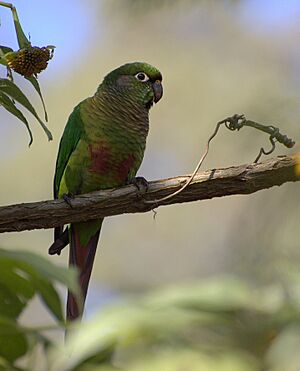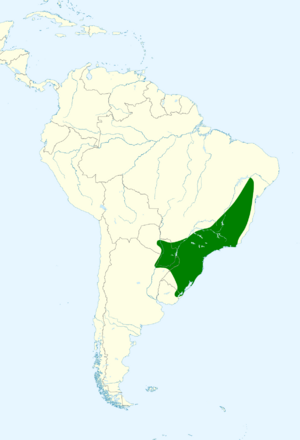Maroon-bellied parakeet facts for kids
Quick facts for kids Maroon-bellied parakeet |
|
|---|---|
 |
|
| Pyrrhura frontalis frontalis São Paulo (Brazil) |
|
| Conservation status | |
| Scientific classification | |
| Genus: |
Pyrrhura
|
| Species: |
frontalis
|
 |
|
| Synonyms | |
|
Pyrrhura frontalis kriegi |
|
The maroon-bellied parakeet (Pyrrhura frontalis) is a small, colorful parrot. You can find these birds in southeastern Brazil, north-eastern Argentina, eastern Paraguay, and Uruguay. People sometimes call them the reddish-bellied parakeet. If you see them as pets, they are often known as the maroon-bellied conure or brown-eared conure.
Contents
About the Maroon-bellied Parakeet
Naming and Discovery
The maroon-bellied parakeet was officially described in 1818. A French bird expert named Louis Vieillot gave it its scientific name, Psittacus frontalis. This name comes from the bird's unique forehead markings.
Later, the bird was moved to a different group of parakeets called Pyrrhura. This group was created in 1856 by another French expert, Charles Lucien Bonaparte.
Different Types of Maroon-bellied Parakeets
There are two main types, or subspecies, of the maroon-bellied parakeet:
- P. f. frontalis (Vieillot, 1818) – This type lives in eastern Brazil.
- P. f. chiripepe (Vieillot, 1818) – This type is found from southeast Brazil to southeast Paraguay and northern Argentina.
Sometimes, you might hear about a type called kriegi. However, most experts now agree that this is just a variation of the main frontalis type. It's not a separate subspecies.
What Do They Look Like?
These parakeets are about 25 to 28 centimeters (10 to 11 inches) long. They are mostly green. They have a special maroon (reddish-brown) patch on their belly. Their chest and sides of the neck look "scaly" with yellow-green stripes. They also have a whitish patch near their ears, which can sometimes look brownish.
A cool feature is their dark maroon forehead. This helps tell them apart from other similar birds. The outer parts of their wing feathers are blue, while the inner parts are green. The tips of these feathers are dark. Their beak is black.
The P. f. frontalis type has a greenish-yellow upper tail that fades into a reddish tip. The P. f. chiripepe type has a greenish-yellow upper tail without the reddish tip.
Where Do They Live and What Do They Eat?
Maroon-bellied parakeets are common in woodlands and at the edges of forests. In the northern parts of their home range, they prefer higher areas, up to 1,400 meters (4,600 feet) high. In other places, they mostly live in lower areas, up to 1,000 meters (3,300 feet).
These birds are quite adaptable. They can even live in city parks, like those in Rio de Janeiro and São Paulo, and find food in gardens. They usually fly in small groups of 6 to 12 birds. Sometimes, you might see groups of up to 40.
Like other Pyrrhura parakeets, they mainly eat fruits, flowers, and other plant parts. They don't often join other bird species when looking for food.
Their Status and Life as Pets
The maroon-bellied parakeet is not considered an endangered species by the IUCN (International Union for Conservation of Nature). This means they are common and not currently at risk.
You can sometimes find these parakeets as pets, especially birds that were raised in captivity. Maroon-bellied parakeets can learn to talk, but their voices might not be very clear. They are known to be among the quieter types of conures. However, their calls can still be quite shrill, which some people might find noisy.



